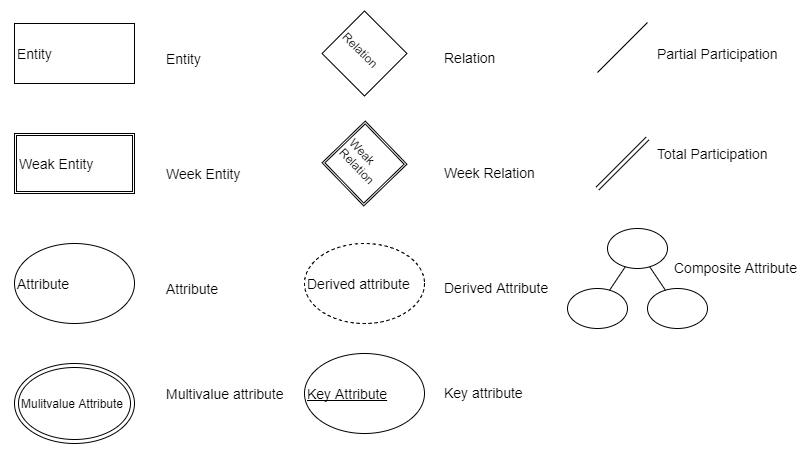The ER diagram represents entities, attributes, and relationships. An entity is a representation of a real-world object such as a car or a user. An attribute is a property of an object and describes it. A relationship represents an association between two or more entities.
The attributes might be composite or simple (atomic). Composite attributes can be divided into smaller subparts. A subpart of a composite attribute provides incomplete information that is semantically not useful by itself. For example, the address is composed of a street name, building number, and postal code. Any one of them isn't useful alone, without its counterparts.
Attributes could also be single-valued or multi-valued. The color of a bird is an example of a multi-valued attribute. It can be red and black, or a combination of any other colors. A multi-valued attribute can have a lower and upper bound to constrain the number of values allowed. In addition, some attributes can be derived from other attributes. Age can be derived from the birth date. In our example, the final rank of a seller is derived from the number of advertisements and the user ratings.
Key attributes can identify an entity in the real world. A key attribute should be marked as a unique attribute, but not necessarily as a primary key, when physically modeling the relation. Finally, several attribute types could be grouped together to form a complex attribute:
Entities should have a name and a set of attributes. They are classified into the following:
- Weak entity: Does not have key attributes of its own
- Strong entity/regular entity: Has a key attribute
A weak entity is usually related to a strong entity. This strong entity is called the identifying entity. Weak entities have a partial key, also known as a discriminator, which is an attribute that can uniquely identify the weak entity, and it is related to the identifying entity. In our example, if we assume that the search key is distinct each time the user searches for cars, then the search key is the partial key. The weak entity symbol is distinguished by surrounding the entity box with a double line.
The following diagram shows the preliminary design of a car portal application. The user entity has several attributes. The name attribute is a composite attribute, and email is a key attribute. The seller entity is a specialization of the user entity. The total rank is a derived attribute calculated by aggregating the user ratings and the number of advertisements. The color attribute of the car is multi-valued. The seller can be rated by the users for certain advertisements; this relation is a ternary relation, because the rating involves three entities, which are car, seller, and user.
The car picture is a subpart attribute of the advertisement. The following diagram shows that the car can be advertised more than once by different sellers. In the real world, this makes sense, because one could ask more than one seller to sell his car:
When an attribute of one entity refers to another entity, some relationships exist. In the ER model, these references should not be modeled as attributes but as relationships or weak entities. Similar to entities, there are two classes of relationships: weak and strong. Weak relationships associate the weak entities with other entities. Relationships can have attributes as entities. In our example, the car is advertised by the seller; the advertisement date is a property of the relationship.
Relationships have cardinality constraints to limit the possible combinations of entities that participate in a relationship. The cardinality constraint of car and seller is 1:N; the car is advertised by one seller, and the seller can advertise many cars. The participation between seller and user is called total participation, and is denoted by a double line. This means that a seller cannot exist alone, and he must be a user.
The many-to-many relationship cardinality constraint is denoted by N:M to emphasize the different participation by the entities.
Up until now, only the basic concepts of ER diagrams have been covered. Some concepts, such as (min, max) cardinality notation, ternary/n-ary relationships, generalization, specialization, and enhanced entity relation (EER) diagrams, have not been discussed.






























































